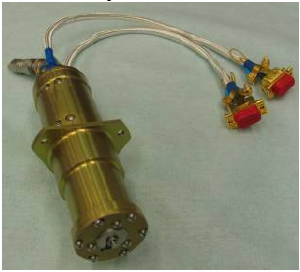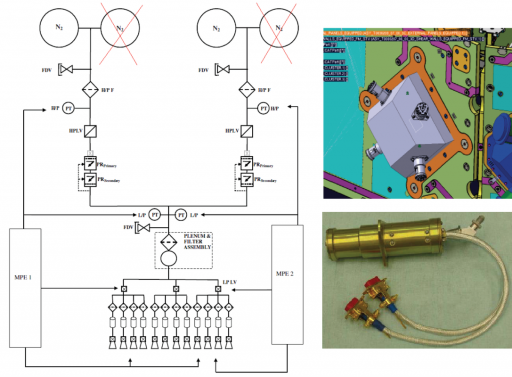Micro Propulsion System

Originally, LISA Pathfinder was to use a Field Effect Electric Propulsion System for the precise attitude and motion control needed to follow the free-falling flight path of the proof masses. This system was replaced by a Cold Gas Micro Propulsion System finding heritage in the Gaia mission.
The LISA Pathfinder spacecraft has to permanently follow its proof masses in their free fall within a closed-loop control scheme called drag-free control. The position of the proof mass relative to its nominal location is measured by the gravitational reference sensor and a high-gain control loop will try to null this error by forcing the spacecraft to follow the proof mass and keep it in its neutral position. The necessary force is imparted on the spacecraft by a set of micro-thrusters.
LPS uses a Micro Propulsion System for fine attitude pointing and angular rate management. The MPS itself consists of the Micro Propulsion Feed Module, Micro Thruster Assemblies and Micro Propulsion Electronics.
The Cold Gas Thrusters are installed on the spacecraft being grouped in two clusters each featuring six cold gas thrusters. The thruster system uses high-pressure Nitrogen propellant to provide very small impulses with a thrust range of 1 Micronewtons to 500 Micronewtons (0.102 to 51 Milligram-Force). The System uses two ARDE Nitrogen Tanks, each containing 28.5 Kilograms of Nitrogen, stored at a pressure of 310 bar.

The two N2 tanks are filled via a single Fill & Drain Valve and supply gas to the propulsion system via a High Pressure Transducer and a High Pressure Latch Valve that pass the gas to two Pressure Regulators (a primary and a secondary) that reduce the gas pressure.
Two Low Pressure Transducers then direct the gas to three Low Pressure Latching Valves that are installed in the Micro Thruster Assemblies – each feeding four thrusters. The MPS pipes are 1/8” Titanium Alloy lines. The thrusters contain valve systems that are commanded via the Micro Propulsion Electronics Assembly. Each electronics unit controls one string of high/low pressure latching valves and six thrusters to provide some fault tolerance.
Each of the thrusters is operated at a low inlet pressure of 1 to 2 bar with a tolerance of up to 4 bar. The Micro Thrusters operate at an N2 mass flow of 0.002 to 1 Milligram per second. The thrusters tolerate more than 500 million on/off cycles and have a lifetime of 20,000 hours at an operational temperature of –20 to +50°C.
